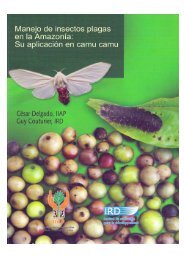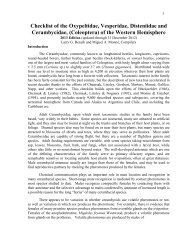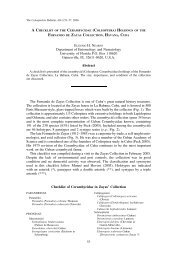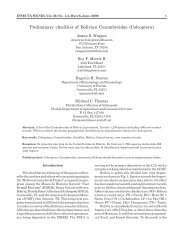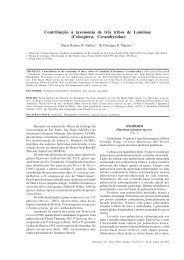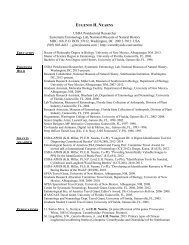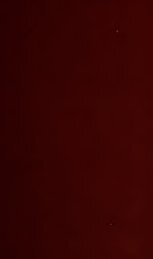Create successful ePaper yourself
Turn your PDF publications into a flip-book with our unique Google optimized e-Paper software.
LAWRENCE S. DILLON <strong>AND</strong> ELIZABETH S. DILLON 121<br />
slightly posteriorly. Pronotum transverse, sides only slightly oblique, nearly<br />
straight, apex feebly narrower than base; disk with the median tubercle subtriangu<br />
lar, confined to ba.sal half, often wanting, each side broadly tumid, tumescence more<br />
or less distinctly subdivided by an oblique impression, sometimes entire disk feebly<br />
tumid and nearly smooth; apical transverse sulcus distinct, interrupted at middle,<br />
basal one deeply arcuate, broad, distinct, more shallow laterally. Scutellum trans<br />
verse; sides straight, oblique; apex feebly arcuate, notched at middle. Eiytra with<br />
sides nearly straight, feebly attenuate to apic.es, each of which is narrowly rounded ;<br />
,disk basally broad tumid, twnescence convex, slightly prominent, entire ba8!'l1 third<br />
covered with numerous, rather coarse, well-spaced punctures, some forming a dis<br />
tinct row along suture, rest irregularly scattered, apical half nearly smooth; hum<br />
erus oblique, prominent, with an obtuse t11bercle, followed by a distinct carina<br />
which rUlls along side of disk to behind middle; sides behind humerus coarsely,<br />
nther densely punctate, punctures evallcent posteriorly, tenninnting at middle.<br />
Prostermlm simple. Procoxae globose, anteriorly strongly uncate; femora all cla<br />
vate, rohust, profemora a little morc robust basally, not rugose; mctntibiae slight.ly<br />
exp..1nded apically. Fifth sternite one-quarter longer than fourth, apex broadly<br />
emarginate. Antennae nearly one-half longer t·han body, with a long fringe beneath<br />
on third a.nd fourth segments, rest with sparse, but long, fringing bairs; scape<br />
mther robust, gradually clavate from middle, bcneath !tt base coarsely rugose; third<br />
segment bisinuate, apical curve feeble; eleventh segment longer than tenth, hooked<br />
at apex.<br />
FEMALE. liead with front less deeply concave between antennal tubercles,<br />
which are less elevated and anned .with only a short, inconspicuous tooth; procoxal<br />
tubercle not acute, feebly prominent ; metatibiae gradually expanded to apex; fifth<br />
stemite about onc-quarter longer than fourth, linearly impressed at middle, apex<br />
feebly arcuate; antennae slightly longer than body; scapc less clavate.<br />
LENGTH 11-16 mm.; width 4.2-6.5 rom.<br />
'l'ype locality.-Cayenne (barii) j Ega (lignicolor).<br />
Distribution.-The Guianas and Peru.<br />
FRENCH GUIANA: 4 t, ; Cayenne; [1 t-A.N.8.P.; 3 $, 2-M.C.Z.J .<br />
BIUT15H GUIANA: t; Kartabo, Bartica District, May 9, 1921; [C.M.].<br />
PERU : it; Rio Santiago, Nov. 21, 1928; [A.M.N.H.]. 5; Mozobamoo, Dep't Saro<br />
Yastin, Nov. Zl, 1936; (F. Woytkowski); [L. Lacey] .<br />
Re11tarks.-Thre is nothing in Bates' description of lignicolor<br />
which will serve to distinguish it from barii.<br />
STERNYCHA Dillon and Dillon, gen. nov.<br />
Distinguished from all other genera of the tribe by the presence<br />
of a large, distinct tubercle on mesosternum anteriorly. Some<br />
what related to Hesycha in farro, but is more robust; elytra less<br />
attenuate ; and antennae in male only slightly longer than body,<br />
the sixth, eighth, and tenth segments with basal two-thirds pale.


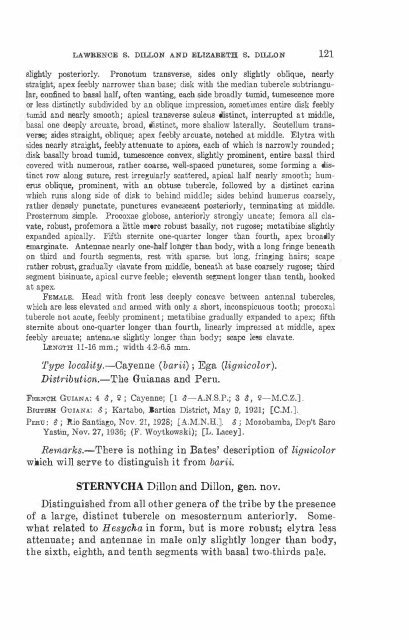
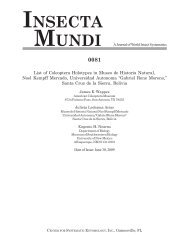
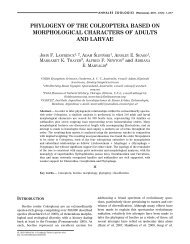


![Coleoptera. Vol. I. [Longicornia. Part I.]](https://img.yumpu.com/41202793/1/180x260/coleoptera-vol-i-longicornia-part-i.jpg?quality=85)
